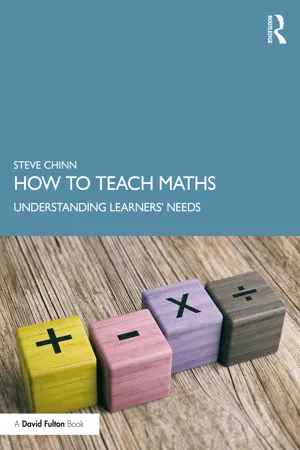
- 158 pages
- English
- ePUB (mobile friendly)
- Available on iOS & Android
About this book
How to Teach Maths challenges everything you thought you knew about how maths is taught in classrooms. Award-winning author Steve Chinn casts a critical eye over many of the long-established methods and beliefs of maths teaching. Drawing from decades of classroom experience and research, he shows how mathematics teaching across the whole ability range can be radically improved by learning from the successful methods and principles used for the bottom quartile of achievers: the outliers. Chinn guides readers through re-adjusting the presentation of maths to learners, considering learners' needs first, and explains the importance of securing early learning to create a conceptual foundation for later success.
This highly accessible book uses clear diagrams and examples to support maths teachers through many critical issues, including the following:
- The context of maths education today
- Topics that cause students the most difficulty
- Effective communication in the mathematics classroom
- Addressing maths anxiety
The perfect resource for maths teachers at all levels, this book is especially useful for those wanting to teach the foundations of mathematics in a developmental way to learners of all ages and abilities. It has the potential to change the way maths is taught forever.
Frequently asked questions
- Essential is ideal for learners and professionals who enjoy exploring a wide range of subjects. Access the Essential Library with 800,000+ trusted titles and best-sellers across business, personal growth, and the humanities. Includes unlimited reading time and Standard Read Aloud voice.
- Complete: Perfect for advanced learners and researchers needing full, unrestricted access. Unlock 1.4M+ books across hundreds of subjects, including academic and specialized titles. The Complete Plan also includes advanced features like Premium Read Aloud and Research Assistant.
Please note we cannot support devices running on iOS 13 and Android 7 or earlier. Learn more about using the app.
Information
Chapter 1
Where we are with maths education
Data on performance in maths
What is happening is that this year (2019) the exams are harder, and the Office of Qualifications and Examinations Regulation [Ofqual] has wanted to keep the grade pattern comparable with previous years, so it has had to lower the number of marks required to get a pass grade. These grades will lead to us fooling ourselves into assuming that young people are doing much better than they actually are. Ofqual are creating an illusion.
Table of contents
- Cover
- Half Title
- Title Page
- Copyright Page
- Table of Contents
- Introduction
- Chapter 1: Where we are with maths education
- Chapter 2: Key identifiers of future and current maths difficulties
- Chapter 3: The core curriculum for arithmetic
- Chapter 4: The developmental nature of maths
- Chapter 5: Topics which cause the most difficulty
- Chapter 6: Learner characteristics and key skills
- Chapter 7: Metacognition
- Chapter 8: Linking facts and concepts
- Chapter 9: The role of language, vocabulary and symbols: Communication and perspectives on communication
- Chapter 10: The inconsistencies of maths and their impact on learning
- Chapter 11: How to use materials and visual images
- Chapter 12: Two visual methods
- Chapter 13: Anxiety and withdrawal
- Chapter 14: Assessment and diagnosis of mathematical difficulties
- Chapter 15: Classroom management
- Chapter 16: Bringing it all together
- Appendix 1 What an 11-year-old is expected to know
- Appendix 2 Books and resources
- Index